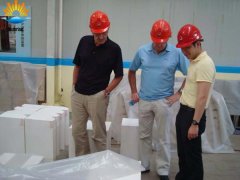Products List
- Silica brick for glass kiln...
- BG-98 superior silica bricks for gla...
- Insulating silica brick...
- High thermal shock resistance and ze...
- High bulk density and High thermal c...
- Unshaped refractory Silica Refractor...
- Silica brick for hot blast stove...
- Silica brick for coke oven...
- Silicon brick for carbon furnace...
Classic Case
-
British Refractories customers to
June 7, 2011 the British Refractories Company custo...
-
Turkish customers to visit our fa
On 26 July,2013 Turkey customers visited our fact...
Refractory Knowledge
Development and Application of Silica Brick
Date:2015-10-28 10:35 From:Zhengzhou Sunrise Refractory Author:admin
Silica brick is the most common silica refractory, with a history of 100 years. Due to its high temperature strength, refractoriness under load, good creep resistance and good resistance to acid slags, it is widely used in the industrial furnaces.
There are 3 crystal phases of silica, tridymite, cristobalite and a small amount of residual quartz. In general, the true density, thermal expansion coefficient, content of tridymite and residual quartz are key performance indicators of silica brick. During firing, quartz is transformed into tridymite with good volume stability and cristobalite with good high temperature performance. The more tridymite and cristobalite, the less residual quartz, the smaller the true density of silica brick, the more stable the volume at high temperature, the smaller the re-expansion. The transformation of crystal phases is closely related to the number and properties of the mineralizing agent. Thus, in addition to raw materials, appropriate mineralizing agent is also very important. In order to improve the performance of silica brick, some other additives are added.
The suitable raw material for silica bricks is mainly quartzite. According to its structure, it can be divided into crystalline silica and silica cement. In general, the purer the crystalline silica, the bigger its density, the larger quartz crystal particles, the slower the transformation when heated. silica cement contains a small amount of impurities and has low purity, small crystalline particles and high content of cement, so the transformation is fast when heated. Therefore, it is important to select reasonable manufacturing methods for different silica bricks according to the characteristics of raw materials.
During the manufacturing process, a certain amount of mineralizing agent are added to prompt the transformation of quartz to tridymite and cristobalite and buffer the rapid expansion caused by crystal phase transformation. Currently, the most widely used mineralizing agents are lime and roll scale. Lime is usually added in the form of lime milk. It can increase the strength of bricks the transformation of quartz to tridymite. Roll scale is often added with lime as a mineralizing agent. It can significantly reduce the viscosity and temperature of the liquid phase and cracks.
In addition to lime and iron scale, some other mineralizing agents are also used. In addition to the type of mineralization agent, the particle size of the mineralizing agent is important. Mineralizing agents with finer particles can distribute more evenly in raw materials and have
According to the purposes, some properties of silica bricks should be improved, such as thermal conductivity, wear resistance and thermal shock resistance. A certain amount of additives are introduced to achieve the desired effect. Sometimes, SiC is added to promote the formation of tridymite and reduce the thermal expansion coefficient and creep rate. Due to the high volume density and thermal conductivity of SiC, thermal conductivity and high temperature strength of the bricks are also increased, with the increase of SiC content. Metals and metal oxides are added since they can increase the bulk density and strength and reduce the porosity of silica bricks.
Silica brick is the main material for coke ovens, accounting for 60% to 70% of the total refractories. It is mainly used in combustion chamber, carbonization chamber, chutes, walls and the crown. Silica brick used in the coke oven mainly consists of tridymite. It should have high softening temperature under load, high thermal conductivity, good thermal shock resistance and good thermal stability. In order to improve the production capacity, silica bricks used in modern large coke ovens are required to have higher density, thermal conductivity and strength and better thermal shock resistance.
Silica brick is widely used in the crown, the front wall and back wall of glass furnaces, due to low cost, high chemical purity, high softening temperature under load, no pollution to glass and good corrosion resistance to R2O gases and acid gases. Silica brick used in glass furnaces mainly consists of cristobalite. In large glass furnaces and oxy-fuel glass furnaces, it should have high purity, good creep resistance and good corrosion resistance.
Silica brick is also widely used in the blast hot stove. It is mainly used in the high temperature areas. Silica brick used in the blast hot stove is mainly composed of tridymite. It should have stable volume and low creep rate under high temperature and load in the long term use and can be continuously used for one or even two campaigns. It should have good thermal shock resistance above 600℃ to be adapted to the temperature changes and maintain the integrity of bricks and masonry.
With the development of high temperature industries, the requirements for silica bricks are higher and higher. In order to meet the demand of the market, silica bricks with better performance are developed or under development.
Contact Us
- E-mail :sales@sunriserefr.com
- Phone : +86-371-63838939
- Fax:+86-371-63835539
- Company Address : No.36 Fengchan Road Of Zhengzhou, Henan, China (Mainland)



